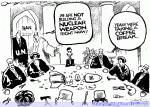Foreign Policy News
It is rare to see America’s policymakers set aside party affiliations or agree to join one another in support of a cause, yet last week, more than 50 members of congress found an exception. From across the U.S. these political figures took part in a virtual conference last week, organized by the Organization of Iranian American Communities to mark the anniversary of the 1979 Iranian revolution for freedom in Iran.
For many Americans, the event is closely connected to the Iran hostage crisis but the conference served to emphasize the original goal of the revolution. In 1979, the people of Iran had rebelled and successfully overthrew the Shah’s dictatorial monarchy with the hope of establishing a truly democratic government. The participants wanted the world to know that this popular movement was not only co-opted by fundamentalists mullahs who established a religious dictatorship, but also that the Iranian people continue to sacrifice for a secular and democratic republic.
Representative Brad Sherman, a California Democrat, expressed understanding of this historical context in his speech. “For too long,” he said, “the Iranian people have been deprived of their fundamental freedoms, for which reason they rejected dictatorship in 1979 and oppose religious tyranny today.” Sherman also noted that he is the chief democratic sponsor of a House resolution that declares support for the organized Iranian opposition movement that has been pushing for a new revolution, with the aim of finally realizing people’s democratic aspirations.
House Resolution 118 bears the signatures of 250 lawmakers – both Republicans and Democrats. This measure was repeatedly alluded to during the conference, including its reference to a 10-point plan for the future of the country, which calls for free and fair elections, separation of religion from the state, legal safeguards on the rights of women and minorities, and so on. That plan, introduced by Iranian resistance leader Maryam Rajavi illustrates the principles and interests of the Iranian people, unmistakably in line with the shared principles and interests of the US and Europe.
Despite the ongoing talks between Iranian regime and world powers in Vienna, solely centered on Iran’s nuclear program, Iranian Americans called for a U.S. approach that takes its cue from the Iranian people and addresses the regime’s other malign behaviors. This includes Iran’s support for international terrorism as well as it active engagement in crimes against humanity.
The lack of urgency in addressing these other ominous behaviors in the shape of appropriate policies, the conference argued, is in large part due to the longstanding misapprehensions about the strength and political stability of Iran’s existing regime. Monday’s OIAC event worked to counter the regime’s own misinformation on this point, not just by correcting the record about the origins of the 1979 revolution but also by pointing to recent developments inside the Islamic Republic which highlight the growing potential for that regime’s overthrow.
Just since the beginning of 2018, Iranians from all walks of life have taken part in eight nationwide uprisings, featuring provocative anti-government slogans like “death to the dictator.” In just the past few weeks, activist affiliated with Madam Rajavi’s movement, known also as the Resistance Units, have set fire to a newly-unveiled statue of the terrorist operative Qassem Soleimani, taken control of state media broadcasts to give the above-mentioned slogans a new outlet, and conveyed those same slogans through public address systems in the shopping centers and public gathering places of major Iranian cities.
Those developments represent a new evolution of the Resistance movement and underscore the defiance of government repression.
In June 2021, Iran’s former Judiciary Chief, Ibrahim Raisi became president of the Islamic Republic and Iranian activists throughout the world began to warn of the potential increase in human rights abuses. Five more uprisings since his assertion to power have driven home the message that public demands for freedom and democracy can not be silenced.
The meeting of US lawmakers conveyed much praise for the Iranian people’s resilience in the face of violent repression. But it also declined to shy away from the responsibility that the US and its allies bear for failing to prevent that repression. Sadly, this is a failure that dates back at least to 1988, when Raisi, then deputy prosecutor for Tehran, played a leading role in the massacre of 30,000 political prisoners. Iranian expatriates warned Western lawmakers about the accelerating death toll at the time, but apart from a largely empty UN resolution, the international community gave no response.
Texas Republican Representative Randy Weber may have had this history of impunity in mind when he used the meeting to declare that, “giving concession to the Iranian regime will embolden them to kill their own people.” And in case the regime’s long history of attacks on human rights was not reason enough for the US to take action, Weber also noted that American interests would be threatened by the regional terrorism and accelerated nuclear activity.
The clear consensus from this virtual event was that the only prudent course of action under present circumstances is to exert the greatest possible pressure on the Iranian regime, the need for accountability for rights violations, with an eye toward supporting the Iranian people as the pattern of uprisings persists.
Among those who know Iranian affairs best, there is little doubt about that persistence. Over the past seven months, Iranian people have made clear progress in that direction, and if the US sees fit to act, that progress could soon lead to true democracy in the heart of the Middle East.











